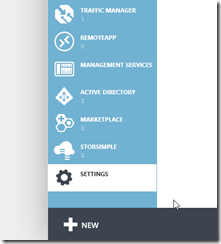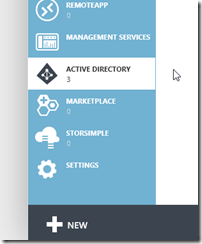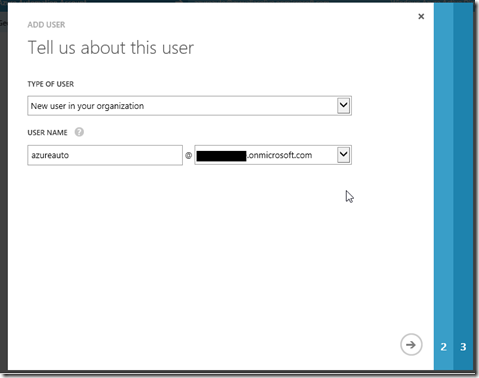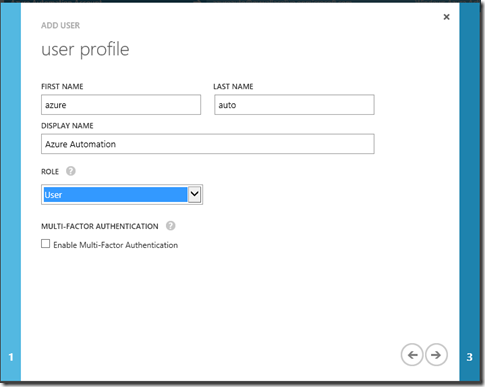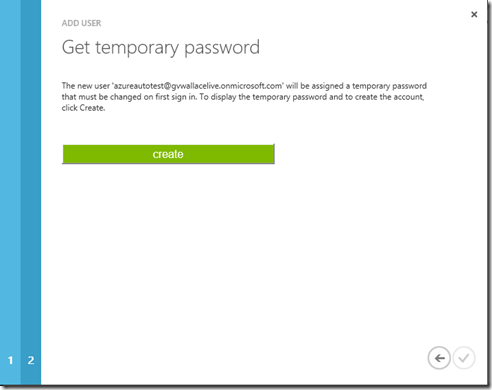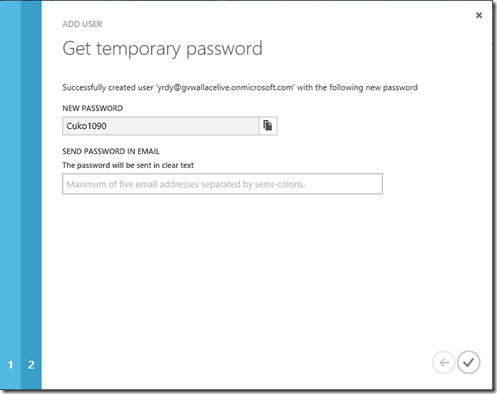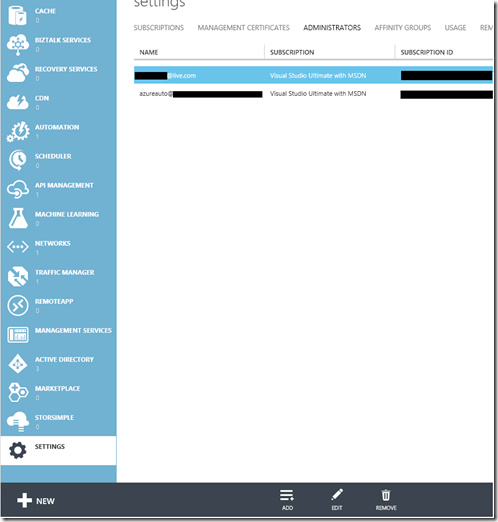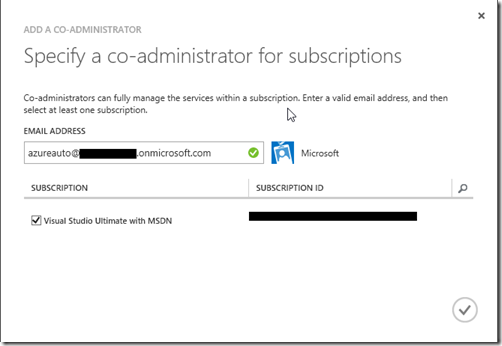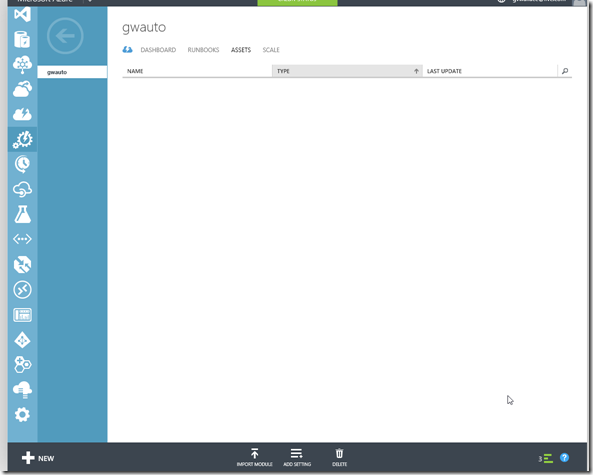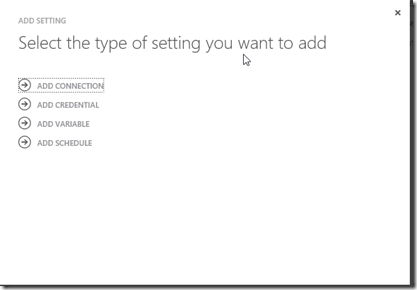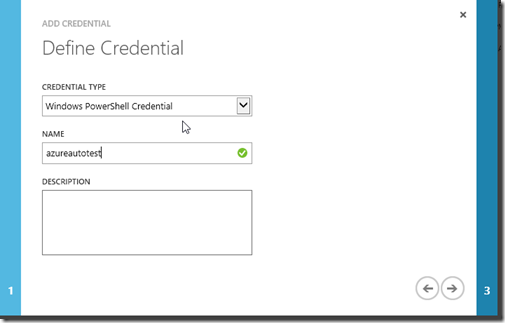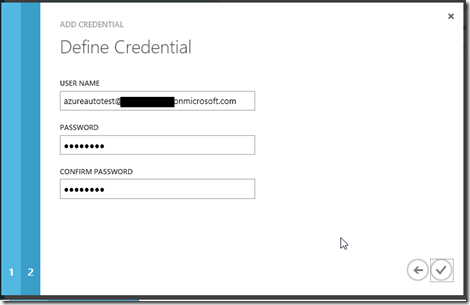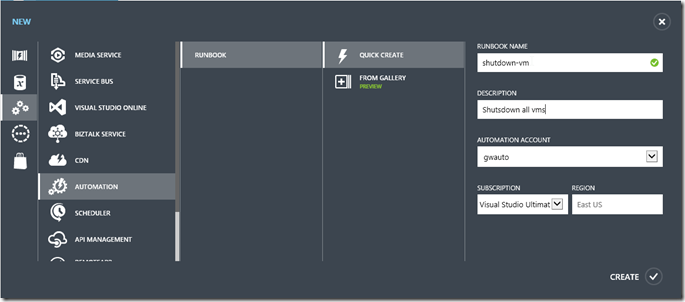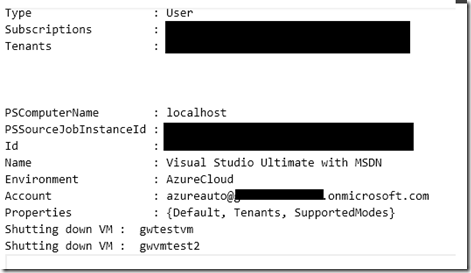Shutting down a Azure VM with Azure Automation
Recently I was asked how to shut down an Azure VM with Azure Automation, it can be a slightly daunting task, due to the fact that you have to use credentials whether or not its a certificate or PSCredentials.. So figured I would write up a post to show how to do this with PSCredentials.
Creating the account
In order to use PSCredentials instead of a certificate, we need an account to use. Lets start by creating an account.
Log into the Azure Management Portal and click on Settings.
Take note of the Directory listed for your subscription, this is important because you could have multiple Azure Active Directories configured.
Next click on Active Directory on the side bar.
Click the Arrow next to the Name of the Azure Active Directory you saw in the Settings tab earlier.
Click on Users and then click Add User at the bottom of the page.
Follow the wizard by choosing “New user in your organization” as a type of user, give the user a username, click the right arrow
Now define the profile components for the account, fill out the appropriate information (First Name, Last Name, Display Name) for the Role choose User
Finally on the last page click Create
On the next page you will be presented with a temporary password for the user. At this point go to https://azure.microsoft.com and log into the Management Portal with the user created, you will be prompted to change the password.
Next go back to the Azure Management Portal with your administrator credentials and click Settings –> Administrators and click Add
Type in the email address of the account you created, choose the subscription they should be part of and click the Check box. The Automation Account needs administrator rights to run.
Configuring Automation
Now we are ready to configure the automation, it is assumed that you have already created an Azure Automation account for the following steps. Click the Automation tab on the left of the Management Portal and click the arrow next to your Automation Account
Click Assets and click Add Setting at the bottom
For the Setting choose Add Credential
For the Credential Type choose Windows PowerShell Credential and give the credential a name, click the right arrow.
Now put in the username and password for the account we created earlier, and click the Checkbox
Now from the bottom left corner of the screen click the Plus sign , choose Automation, Runbook, and Quick Create. Give the runbook a good name and description and click Create
Next click the Arrow next to the newly created runbook to go to the runbook details.
Click Author and now we are ready to create the runbook.
Paste the following code into the designer, where the Name for Get-AutomationPSCredential is the Name of your credentials you created earlier. You can always click (Insert, Setting) at the bottom of the window and choose Get Windows PowerShell Credential and is will show you all the credentials you have. This will also paste in the command to get the credentials.
workflow shutdown-vm
{
$Cred = Get-AutomationPSCredential -Name 'Azure Auto'
Add-AzureAccount -Credential $Cred
InlineScript
{
Select-AzureSubscription -SubscriptionName "Visual Studio Ultimate with MSDN"
$VMS = Get-AzureVM
foreach($VM in $VMS)
{
$VMName = $VM.Name
Stop-AzureVM -ServiceName $VM.ServiceName -Name $VM.Name -Force
Write-Output "Shutting down VM : $VMName "
}
}
}
Now it is time to test, if you have VMs just click the Test button
Finally once you test, you should get output similar to below.
Hope this helps someone out there.
Comments
- Anonymous
January 01, 2003
Glad to hear Dirk. - Anonymous
January 01, 2003
Great Article George. This would certainly come in handy to one and all. Thanks for sharing. - Anonymous
January 01, 2003
Great post. Thank you. - Anonymous
November 06, 2014
This was exactly what I was looking for. Much better then trying to do this from within the VM itself. Thanks for the step by step! - Anonymous
February 10, 2015
Wonderful, saved probably hours of try and error. Thanks a lot! - Anonymous
March 30, 2015
http://www.google.com">goo - Anonymous
March 30, 2015
I receive many links saved in my notepad and found yours cause it is interesting. - Anonymous
April 03, 2015
Many of you use Free MSDN Azure account for Dev/Test. This post is all about using Free Azure account - Anonymous
November 27, 2015
Nice! very useful! - Anonymous
December 15, 2015
you mean to use azureauto@..... account not azureautotest@... since you do not have a azureautotest@.... account created - Anonymous
December 15, 2015
or do we need 2 accounts, one that is set as administrator (azureauto) to the subscriptions and another one for the automation(azureautotest) ? Can they be the same, I see when you define the credential actually you are actually creating a new account, thanks for clarifying it, or am i the only one confused ? - Anonymous
December 15, 2015
Bob, there are two things in play here.. one is the account in Azure Active Directory.. then there is the automation credential that references the account. To attempt to avoid confusion I named the automation account differently so it was known that they are two different things. The runbooks would reference the automation account of "azureautotest" - Anonymous
January 12, 2016
I'm having the following error log. Any idea?
1/12/2016 9:49:43 AM, Error: Add-AzureAccount : Cannot bind argument to parameter 'Credential' because it is null.
At shutdown-vm:4 char:4
+
+ CategoryInfo : InvalidData: (:) [Add-AzureAccount], ParameterBindingValidationException
+ FullyQualifiedErrorId :
ParameterArgumentValidationErrorNullNotAllowed,Microsoft.WindowsAzure.Commands.Profile.AddAzureAccount
1/12/2016 9:49:44 AM, Error: Select-AzureSubscription : The subscription name Pay-As-You-Go doesn't exist.
Parameter name: name
At shutdown-vm:6 char:6
+
+ CategoryInfo : CloseError: (:) [Select-AzureSubscription], ArgumentException
+ FullyQualifiedErrorId : Microsoft.WindowsAzure.Commands.Profile.SelectAzureSubscriptionCommand
1/12/2016 9:49:51 AM, Error: Get-AzureVM : No default subscription has been designated. Use Select-AzureSubscription -Default to
set the default subscription.
At shutdown-vm:6 char:6
+
+ CategoryInfo : CloseError: (:) [Get-AzureVM], ApplicationException
+ FullyQualifiedErrorId : Microsoft.WindowsAzure.Commands.ServiceManagement.IaaS.GetAzureVMCommand - Anonymous
January 12, 2016
Solved: Wrong Credentials :) - Anonymous
February 24, 2016
The comment has been removed - Anonymous
February 29, 2016
To learn how such Azure VM automation can be monitored and systematized, check out two blogs below:
VMs can be shutdown or scaled down on a schedule.
Shut-down Azure VMs on a schedule: http://cloudmonix.com/blog/how-to-automate-schedule-shutdowns-of-azure-vms/
Scale-down Azure VMs on a schedule: http://cloudmonix.com/blog/how-to-automate-scaling-of-azure-vms/ - Anonymous
April 18, 2016
Wonderful, was thinking about this one for quite some time..
